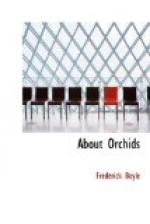It would mislead the unlearned public, and would not greatly interest them, to go through the catalogue of an orchid sale and quote the selling price of every lot. From week to week the value of these things fluctuates—that is, of course, of bulbs imported and unestablished. Various circumstances effect it, but especially the time of year. They sell best in spring, when they have months of light and sun before them, in which to recover from the effects of a long voyage and uncomfortable quarters. The buyer must make them grow strong before the dark days of an English winter are upon him; and every month that passes weakens his chance. In August it is already late; in September, the periodical auctions ceased until lately. Some few consignments will be received, detained by accident, or forwarded by persons who do not understand the business.
That instance of Odontoglossum Alexandrae shows well enough the price of orchids this month, and the omission of all that followed illustrates it. The same lots would have been eagerly contested at twice the sum in April. But those who want that queenliest of flowers may get it for shillings at any time. The reputation of the importer, and his assurance that the plants belong to the very best type, give these more value than usual. He will try his luck once more perhaps this season; and then he will pot the bulbs unsold to offer them as “established” next year.
Oncidium luridum follows the Odontoglots, a broad-leaved, handsome orchid, which the untrained eye might think to have no pseudo-bulb at all. This species always commands a sale, if cheap, and ten shillings is a reasonable figure for a piece of common size. If all go well, it may throw out a branching spike six or seven feet long next summer, with—such a sight has been offered—several hundred blooms, yellow, brown and orange, Oncidium juncifolium, which comes next, is unknown to us, and probably to others; no offer is made for its reed-like growths described as “very free blooming all the year round, with small yellow flowers.” Epidendrum bicornutum, on the other hand, is very well known and deeply admired, when seen; but this is an event too rare. The description of its exquisite white blossoms, crimson spotted on the lip, is still rather a legend than a matter of eye-witness. Somebody is reported to have grown it for some years “like a cabbage;” but his success was a mystery to himself. At Kew they find no trouble in certain parts of a certain house. Most of these, however, are fine growths, and the average price should be 12s. 6d. to 15s. Compare such figures with those that ruled when the popular impression of the cost of orchids was forming. I have none at hand which refer to the examples mentioned, but in the cases following, one may safely reckon shillings at the present day for pounds in 1846. That year, I perceive, such common species as Barkeria spectabilis fetched 5l. to 17l. each; Epidendrum Stamfordianum,




